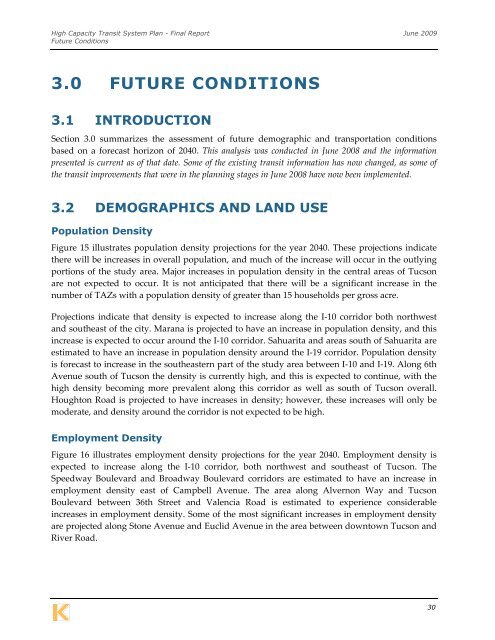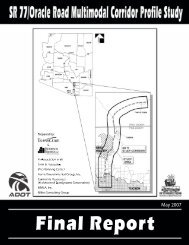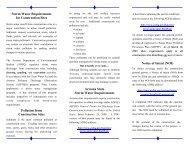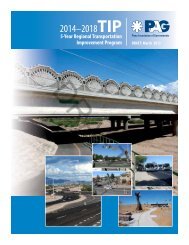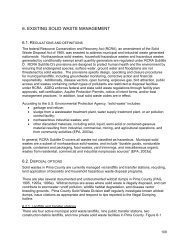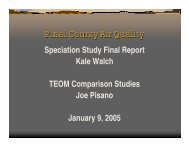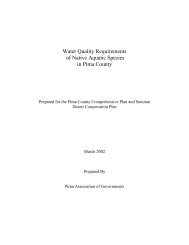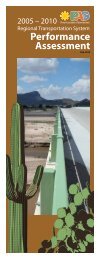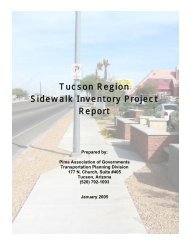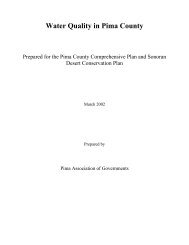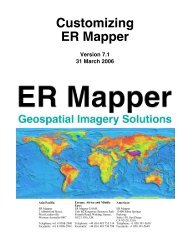Final Report - Pima Association of Governments
Final Report - Pima Association of Governments
Final Report - Pima Association of Governments
You also want an ePaper? Increase the reach of your titles
YUMPU automatically turns print PDFs into web optimized ePapers that Google loves.
High Capacity Transit System Plan - <strong>Final</strong> <strong>Report</strong> June 2009<br />
Future Conditions<br />
3.0 FUTURE CONDITIONS<br />
3.1 INTRODUCTION<br />
Section 3.0 summarizes the assessment <strong>of</strong> future demographic and transportation conditions<br />
based on a forecast horizon <strong>of</strong> 2040. This analysis was conducted in June 2008 and the information<br />
presented is current as <strong>of</strong> that date. Some <strong>of</strong> the existing transit information has now changed, as some <strong>of</strong><br />
the transit improvements that were in the planning stages in June 2008 have now been implemented.<br />
3.2 DEMOGRAPHICS AND LAND USE<br />
Population Density<br />
Figure 15 illustrates population density projections for the year 2040. These projections indicate<br />
there will be increases in overall population, and much <strong>of</strong> the increase will occur in the outlying<br />
portions <strong>of</strong> the study area. Major increases in population density in the central areas <strong>of</strong> Tucson<br />
are not expected to occur. It is not anticipated that there will be a significant increase in the<br />
number <strong>of</strong> TAZs with a population density <strong>of</strong> greater than 15 households per gross acre.<br />
Projections indicate that density is expected to increase along the I‐10 corridor both northwest<br />
and southeast <strong>of</strong> the city. Marana is projected to have an increase in population density, and this<br />
increase is expected to occur around the I‐10 corridor. Sahuarita and areas south <strong>of</strong> Sahuarita are<br />
estimated to have an increase in population density around the I‐19 corridor. Population density<br />
is forecast to increase in the southeastern part <strong>of</strong> the study area between I‐10 and I‐19. Along 6th<br />
Avenue south <strong>of</strong> Tucson the density is currently high, and this is expected to continue, with the<br />
high density becoming more prevalent along this corridor as well as south <strong>of</strong> Tucson overall.<br />
Houghton Road is projected to have increases in density; however, these increases will only be<br />
moderate, and density around the corridor is not expected to be high.<br />
Employment Density<br />
Figure 16 illustrates employment density projections for the year 2040. Employment density is<br />
expected to increase along the I‐10 corridor, both northwest and southeast <strong>of</strong> Tucson. The<br />
Speedway Boulevard and Broadway Boulevard corridors are estimated to have an increase in<br />
employment density east <strong>of</strong> Campbell Avenue. The area along Alvernon Way and Tucson<br />
Boulevard between 36th Street and Valencia Road is estimated to experience considerable<br />
increases in employment density. Some <strong>of</strong> the most significant increases in employment density<br />
are projected along Stone Avenue and Euclid Avenue in the area between downtown Tucson and<br />
River Road.<br />
30


